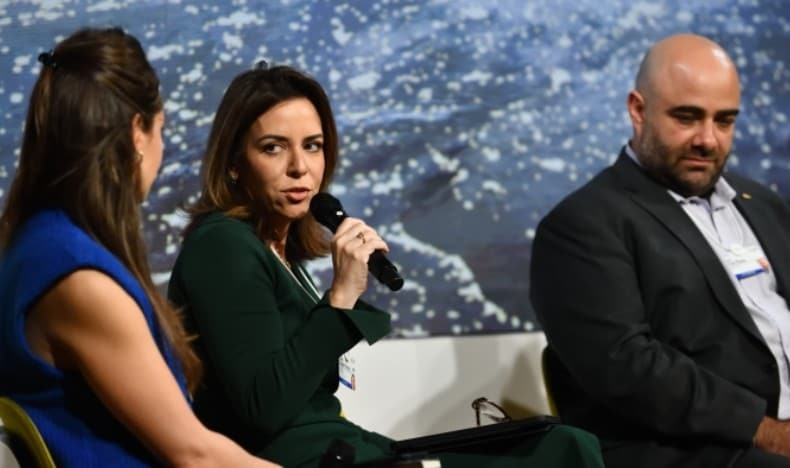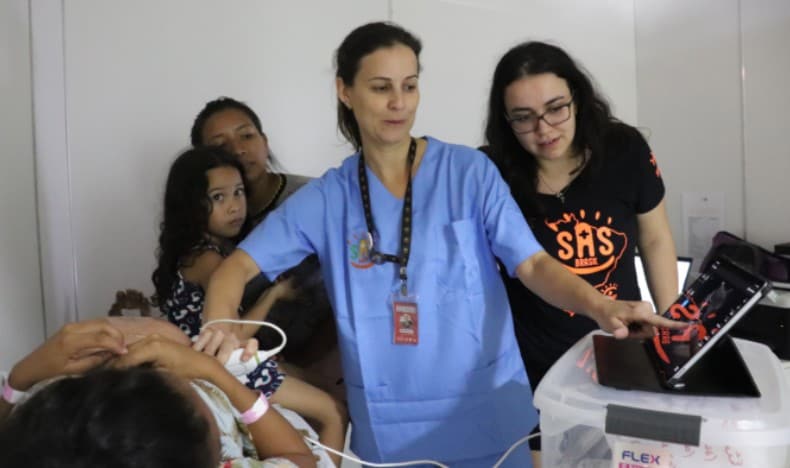How collaboration can help in the fight against non-communicable diseases
May 19, 2025 | 3 minute read
Ongoing global health challenges, like non-communicable diseases (NCDs), are important drivers in shaping international health efforts. Now more than ever, it's essential for healthcare collaborations to prioritize building a future where healthy living is a key factor.

At the World Economic Forum's annual meeting, Philips hosted a panel discussion, 'Heart of the Matter: Cardiac Care as a catalyst for scaling global health innovations', that explored how collaborations can positively impact global health.
The conversation focused on the potential to enhance patient outcomes and drive opportunities by leveraging the power of data, technology and tools, infrastructure and partnerships, for global health improvement, with cardiac care as a potential model.
Moderated by Elissa Miolene, development reporter at Devex, the panel brought together thought leaders in healthcare from across the industry, including Eric Cioè Peña, founder and VP of Northwell Health’s Center for Global Health, Sabine Bolonhini, CEO of non-profit social organization SAS Brasil, Carla Haddad Mardini, UNICEF’s Director of Private Sector Partnerships and Fundraising, and Philips Chief Medical Officer Carla Goulart Peron.
The full panel discussion can be viewed here. Below is a snapshot of some of the questions that were put to them:
What makes innovation in caring for NCDs, and cardiac care in particular, so important?
In a world where NCDs account for 74% of deaths worldwide, innovative solutions are needed to reduce their impact on public health [1]. Cardiovascular disease ranks as the leading cause worldwide with 32% of deaths. Stroke, another NCD, comes in at number two. These statistics underscore the importance of addressing NCDs as part of the United Nations (UN) Sustainable Development Goals (SDGs).
While progress is being made, it’s far from where it should be. But there are real successes happening across the healthcare industry, and in cardiac care, when it comes to international collaboration efforts.
“If we think about stroke, it’s a completely treatable disease and we have technologies and treatments to cure it if performed in time. But unfortunately, very few patients can access them,” commented Philips CMO Carla Goulart Peron. “If you can access a stroke care center where thrombolytics and thrombectomy can be implemented in a matter of minutes it can save your life. But if you are miles away from a center, you may not even have access to thrombolytics.”
When it comes to grappling with the impact of NCDs, and cardiovascular disease specifically, innovations in healthcare that are scalable and fundable are essential for confronting them globally. From prevention and treatment to innovative management strategies and technologies, these advancements have the potential to help close global healthcare gaps.

Carla Goulart Peron of Philips says that the right technology and partnerships can make a difference in patient outcomes.
Why are partnerships so important for improving global health outcomes?
It’s a topic that’s close to the heart Carla Goulart Peron: “Ten years ago, I was lucky enough to be part of Doctor Sheila Martins’ clinical study in Brazil, looking for ways to enable mechanical thrombectomy to be implemented in the public health system. That was unimaginable, right? Cost-wise impossible. Infrastructure-wise impossible. But by bringing together the right technology and the right partnerships with industry, non-profits, and governments you can actually make a difference to patient outcomes.”
Eric Cioè-Peña, Sabine Bolonhini and Carla Haddad Mardini added their own success stories.
Eric Cioè-Peña: “We’re delivering telemedicine in the middle of the Amazon in rural Guyana using satellite communications and community health workers – not just connecting community health workers to clinicians but also making them more potent healthcare actors through training and the use of technology.”
Sabine Bolonhini: “With SAS Brasil we’re equipping containers called Advanced Telemedicine Units with devices such as ultrasound and ECG recorders and then training local professionals – nurses and technicians – to operate them. The challenge for people who develop innovations is they often don't know how to get to the last-mile delivery. So, these are two separate areas of knowledge. The success we have had is when we blend them together. And that requires partnership and collaboration.”
Carla Haddad Mardini: “Where UNICEF can help is with the fact that we're present in most, if not all low- and middle-income countries with decades of experience. Investment sometimes doesn't go to these areas because of a perceived risk, especially in countries that are complex in terms of development or humanitarian emergencies. This is where UNICEF can give an assessment of what is happening on the ground, because of its strong presence across local communities.”

How can (private sector) innovation in cardiac care help drive global efforts in tackling other NCDs?
Eric Cioè-Peña pointed out that (private sector) industry has one big advantage not often enjoyed by the public sector – the permission to fail. “The private sector is very good at trying things and if it works, great. If it doesn't work, we pivot and try something new. The public sector has a much harder time doing that.”
Added Carla Goulart Peron: “Industry can bring expertise in developing technology – artificial intelligence (AI) for example. So, we need to make sure that we're engaging with regulators to make sure it’s safe and performing as intended. Then we need to partner with the providers to make sure it is used properly.”
Sabine Bolonhini: “Being on the ground and doing the work, we've made a lot of mistakes. But by learning from those mistakes, SAS Brasil has now developed an open-source model that is refined and works. Why not train other governments and other institutions to do what we do, to share what we've learned, but also tap into their unique knowledge as well?”

To improve primary healthcare in hard-to-reach areas of Brazil, Philips Foundation and SAS Brasil deployed a digital connected healthcare solution. Photo copyright SAS Brasil.
What are some ways to achieve an impactful collaboration?
The panel unanimously agrees it’s about speaking the same language, taking a long-term view and bringing a fresh perspective. The opinions and clinical experiences presented herein are specific to the featured presenters and are for information purposes only. The results from their experiences may not be predictive of all cases. Individual results may vary depending on a variety of patient-specific attributes and related factors. Nothing in this presentation is intended to provide specific medical advice or to take the place of written law or regulations. Results are specific to the institution where they were obtained and may not reflect the results achievable at other institutions.
Carla Haddad Mardini: “It’s critical to speak the same language across different industries and sectors, so everyone can feel part of it. Today, this common language is the UN Sustainable Development Goals. It’s quite promising to see that, when initiatives scale, they naturally generate more funding.”
She adds that it’s important for the private industry to bring their core assets and business expertise to bear, beyond basic corporate social responsibility approaches. “Corporate social responsibility is important, as long as it is not just operating on the periphery. We need to move away from traditional charity approaches or small projects to the co-design of sustainable solutions on a scale that bring the assets of every single entity across the whole value chain. We need a mindset shift.”
Eric Cioè Peña added: “Achieving greater access to these life-saving treatments may seem challenging, but I believe it’s a justifiable investment. Having someone in their 30s, 40s or 50s disabled by stroke for the rest of their lives is an enormous burden on a country's health system.”
Finally, Carla Goulart Peron concluded: “If we can’t align the goals of all the institutions and key stakeholders, we'll never get there. I decided to join Philips because Philips has a specific goal of reaching medically underserved communities. We need to open up space and create a creative, protected environment to build different business models that accomplishes common goals for all stakeholders.”








